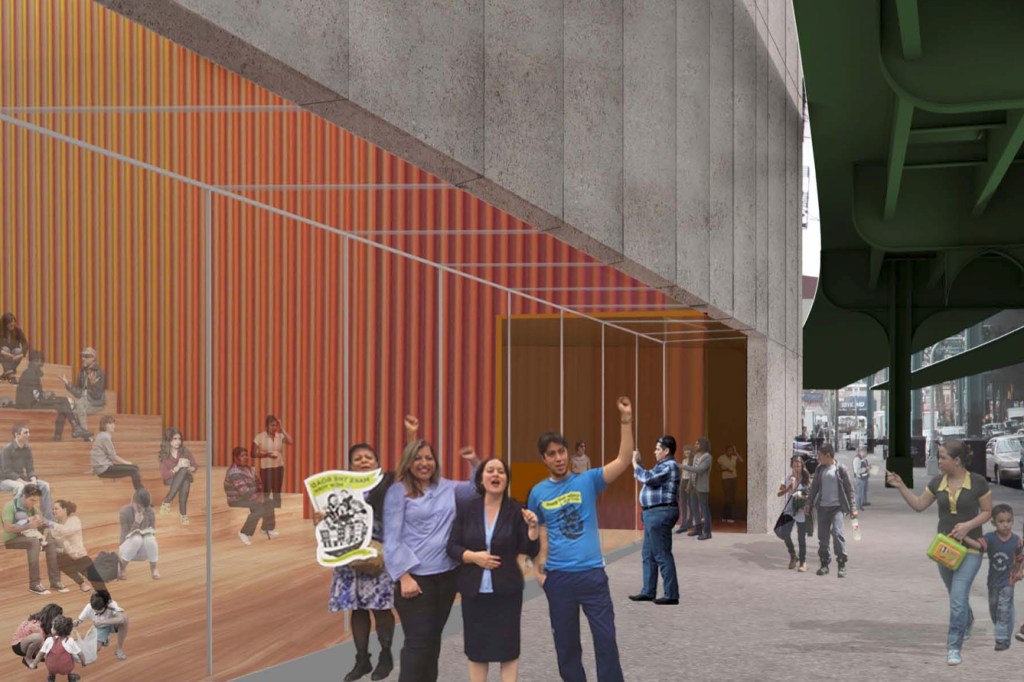While sitting in the crowded waiting area of Make the Road New York’s storefront offices in Queens, formerly a Blockbuster video outlet, I think about my grandmother. She left Poland at 18 and, working as a seamstress along the way, immigrated to America in the late 19th century. She eventually opened a Kosher restaurant in Hoboken, N.J., where my mother grew up, safely, happily, and far from the nightmare that overtook the family that remained in Poland. It doesn’t take much empathy or imagination to make the connection between my family’s story—more or less the story of most American families—and those of the people around me on a March afternoon, mainly Spanish-speaking women, waiting for healthcare counseling or an appointment with a lawyer. Until recently, the scene at Make the Road New York (MRNY) would have been just another heartwarming portrait of the American fabric, part of the melting pot or the gorgeous mosaic. We used to be proud of our immigrant heritage, of our openness to those seeking a better place to live.
With over 23,000 dues-paying members, MRNY is one of New York City’s most formidable immigrant rights organizations. Founded in 2007 as a merger of two smaller groups, it has taken on a wide range of issues that affect immigrant communities: workers’ rights, access to healthcare, and all the problems associated with the current administration’s punitive approach to immigration law. MRNY, which derives its name from a poem by the Spanish writer Antonio Machado (“Searcher, there is no road. We make the road by walking.”), used to be famous, locally at least, for its work on behalf of the carwasheros, the men who dry and buff newly washed cars, mostly for tips (which were often pilfered by the management). Since the dawn of the Trump administration, MRNY has increasingly been on the front lines of a cultural and political war, protesting almost daily. The waiting area where I sat was decorated with artifacts of those demos, cardboard signs shaped like butterflies, with slogans like “Resist,” “Rise Up,” and “Here to Stay.”
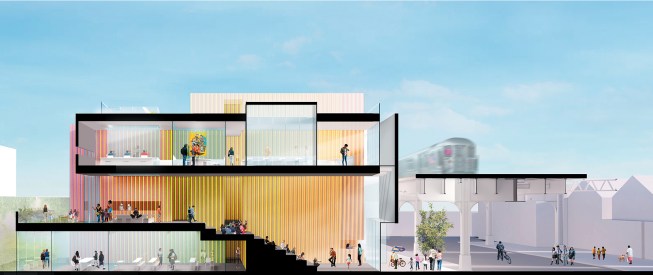
Courtesy Make the Road NY; TEN Arquitectos
Sectional rendering of MRNY’s new home
In February, MRNY made an announcement on Twitter, not of a protest but of a groundbreaking: A rendering of an architectural section showed a tightly configured, 24,000-square-foot modern building, all glass and corrugated metal, with the 7 train immediately adjacent, a ghostly blur, roaring by on elevated tracks. I was amazed that a grassroots organization was building from the ground up and had obviously hired an architect. My assumption was that, somehow, Trump’s barrage of anti-immigrant invective had helped elevate the group politically and financially, making a project of this scope possible.
I was half right. There is an architect involved, specifically the New York branch of Enrique Norten, Hon. FAIA’s firm, TEN Arquitectos, founded in Mexico City. But I was wrong about the project’s genesis. In my first conversation with Andrea Steele, AIA, who runs the New York office, she said that the firm was hired prior to the 2016 election. Then, soon after, MRNY told her, “We need to speed things up.”
An Anchor and a Beacon
Depending on whom you ask, MRNY’s project to build a permanent home in Queens goes back even further—nearly a decade or more. Including the former Blockbuster store, the organization maintains five rented offices in New York City, Westchester, and Long Island. Co-executive director Javier Valdés, whose parents are from Argentina, moved to the U.S. when he was in junior high school. He tells me that he first saw the value in owning instead of renting in 2011 when he and some colleagues visited the headquarters of a farmworkers union in Woodburn, Ore. “They owned a radio station. They owned affordable housing. They owned a community center,” he recalls. While it’s simpler to amass property in Oregon than it is in New York City, the model was appealing: “They’re an institution that’s a little bit older than ours, and they’ve been able to pass this level of equity, generation to generation.”
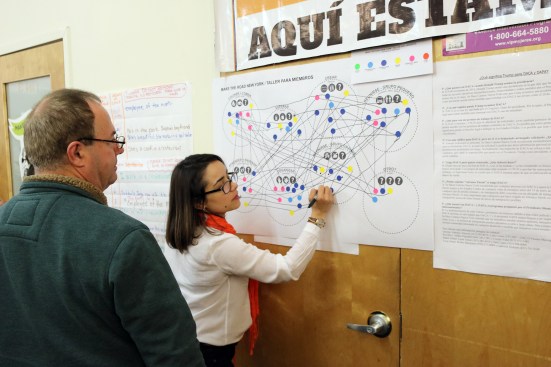
Courtesy Hester Street
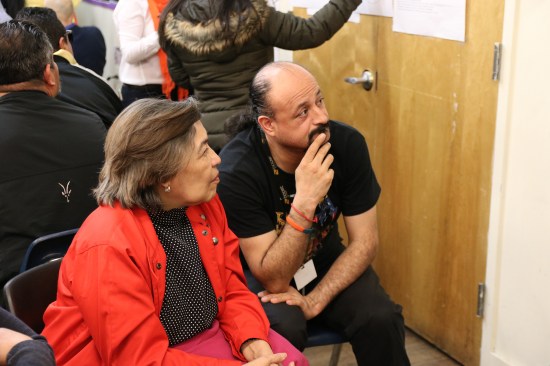
Courtesy Hester Street
Scenes from the charrette-style meetings that helped inform the design of MRNY's new home
As Valdés walked me down Roosevelt Avenue in Queens, a street pulsating with the kind of vitality that lately has gone AWOL from large parts of Manhattan, he explained that gentrification has relentlessly followed the path of the 7 train deeper and deeper into Queens, gradually encroaching on MRNY’s territory. “We were really concerned because of the increasing real estate pressures. What’s going to happen to the future of the organization?” Owning a building would allow them “to drop an anchor in the community and say that we’re here long term.” Also, the current Jackson Heights facility, a warren of small- to medium-sized rooms, simply wasn’t designed to house a growing community’s needs.
“At the moment that Trump is trying to build up walls, we’re trying to break down walls and invite people in.”
MRNY turned to a friend of the organization, the urban planner Betsy MacLean, who, at the time, was developing affordable housing for the Cypress Hills Local Development Corp. in East New York, a stubbornly ungentrified corner of Brooklyn. From her work at Cypress Hills, MacLean understood the funding mechanisms available to New York City nonprofits. According to Valdés, “She says, ‘This is actually doable. You will need to get some political support to be able to raise capital from the city of New York.’ ”
In 2014, MacLean took a new job, executive director of Hester Street, an organization based in New York’s Chinatown that began as a modest spinoff of a small architecture firm called the Leroy Street Studio. A civic group, it helps nonprofits and community groups do urban planning and real estate development. In her new role, MacLean steered MRNY to its local city council member, Julissa Ferreras-Copeland, who had just become the council’s finance chair, and the organization secured enough of a grant to pay for a feasibility study—which, of course, was conducted by Hester Street. “We did a bunch of interviews with leadership,” MacLean recalls, “with staff. We did surveys. We did a couple of kind of charrette-type meetings to identify: So, what do you need? What does this look like? And then we dove into their finances to figure out what they could afford. And knowing what sources are out there for community facility development, how we could start to assemble those pieces.”
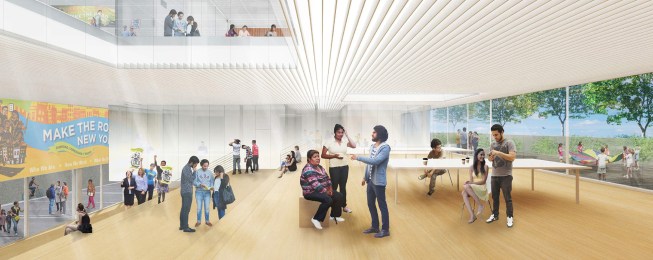
Courtesy Make the Road NY; TEN Arquitectos
The center’s main gathering space, with bleacher seating
MRNY secured $5.6 million through the city council and the Queens borough president’s office to cover construction costs. To purchase the vacant lot they discovered, just 10 blocks up Roosevelt Avenue from their current offices, they borrowed money from the Local Initiatives Support Corp. (LISC), which is a conduit for the kind of funding that is typically generated by tax credits. All told, MacLean helped piece together a mosaic of loans, grants, and tax credits, funding about 75 percent of the estimated $30 million cost of the project. The other 25 percent will come from MRNY’s fundraising efforts.
A Cold Call to TEN Arquitectos
Hiring the right architect was more complex than finding funding, and also part of Hester Street’s job. “Our criteria were great design, experience working with government money, and working within a budget,” MacLean says. She also was searching for a firm that wasn’t, like much of the profession, “overwhelmingly white and male.” She worked her way through a short list without nailing that “exact mix.” A late night internet search lead MacLean to TEN Arquitectos. “I reached out to Andrea, cold-called her, and to her credit, she was down immediately. She was there.”
“We were really intrigued by TEN Arquitectos,” Valdés recalls, “primarily because they were bicultural. Most of their staff spoke Spanish. They understood our organization. They were able to do the focus groups in Spanish, which was critical.”
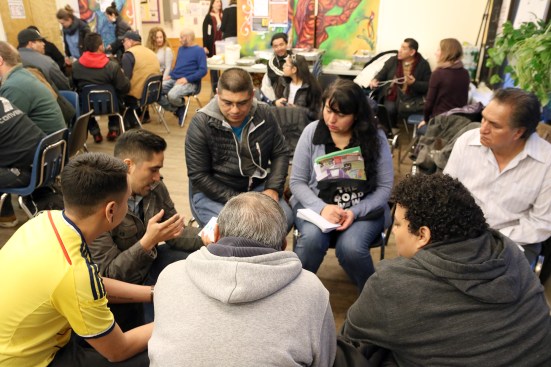
Courtesy Hester Street
Another scene from the charrette-style meetings
MRNY wanted enough space and flexibility to hold two group meetings simultaneously, and enough smaller offices to offer staffers and members who’d arrived for, say, meetings with immigration lawyers, a modicum of privacy. But the main things the organization wanted from the new building were increased visibility and permanence—a physical manifestation of a favorite slogan, “We’re Here to Stay.” Everyone I spoke with about the project called it a “beacon.” Valdés: “We’re hoping this will be a beacon.” Steele, noting how the building will be visible to everyone riding by on the 7 train: “They really need to be a beacon for the larger community of the city.” I’m guessing it’s no accident that the word calls to mind the final words of the Emma Lazarus poem on Lady Liberty’s torch: “I lift my lamp beside the golden door!”
The focus groups helped clarify the spirit of those aspirations. “We really wanted to understand, not just the flows through the building and the basic circulation, but how this building and how this entity changes the directions of people’s lives,” Steele told me. The primary thing, she determined, was giving the organization a great communal space. “They come together every night. To speak about what they’ve done, to speak about what they still need to do. To collectively share stories. Their strength always comes from the collective.”
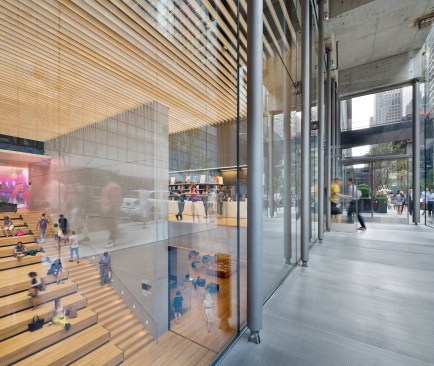
Michael Moran/OTTO
TEN Arquitectos’ New York Public Library branch on 53rd Street
MRNY came across a likely architectural approach in another TEN Arquitectos project: “We visited some of the spaces they themselves had designed,” Valdés says. “We were very much moved by [their] design of the New York Public Library across from MoMA.” Like the library, the dominant element in MRNY’s building will be a set of bleachers, clad in wood, and highly visible behind a wall of glass. This will be the community center’s main space, where members will convene to hang out, to be among friends, or to discuss topics like education, environmental issues, and transgender rights.
A passageway next to the bleachers leads deeper into the building, to office space and to classrooms where English, reading, and citizenship will be taught. Adjacent to the main space is a day care center and also a dedicated space for teenagers. A series of strategically placed cutouts will bring sunlight down into the building’s lower levels; there’s room on the deep lot for a courtyard out back. The building has two kitchens; communal dining is a big part of MRNY culture, as is coffee. “The flavors are important,” notes Valdés.
When I visited the site in March (the projected completion date is sometime next year) it was just a fenced-in patch of dirt, with the shovels from the February groundbreaking lying on a mound of earth in the center. Valdes wanted me to see the site so I could feel the energy of the surrounding neighborhood and understand how pivotal the community center will be. The new building will face Roosevelt Avenue, with the 7 train passing by one flight up every few minutes; the 103rd Street station is two short blocks away. Originally, the plan was to make the building’s entire street wall out of glass, but concerns about train noise and the budget won out. Now the second-story façade will be concrete with a cutout allowing subway riders a glimpse of a glassed-in conference room, and there’ll be graphics at the level of the elevated track to catch the eye of passing commuters.
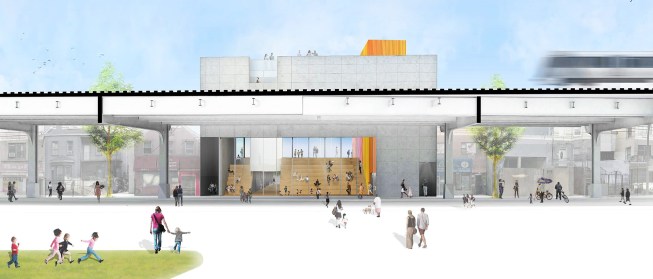
Courtesy Make the Road NY; TEN Arquitectos
View from Corona Plaza
The most significant thing about the location is that directly across the street is Corona Plaza, a public space created on what was, until recently, a street. “Corona Plaza is a pure extension of their space,” Steele says: A funnel of patterned pavement sends pedestrians to the perfect vantage point where, through the windows, they can see MRNY members gathering on the big steps.
“In Latin America, you usually have the main plaza, the church, and the municipality,” Valdés told me. MRNY has got the plaza, and there’s a post office that stands in as a symbol of municipal government. “And we want to be the church, not in the sense of a place of worship, but as a place where people gather.”
The Opposite of a Wall
Hanging around on the site, watching the trains go by, I’m struck by how much optimism and courage it takes for an immigrant rights group to build a largely transparent community center in the age of Trump. As Valdés told me: “My hope is that every person that is a new migrant in the city knows that this is a place they can go to.” At the same time, there’s something unsettling about a building so conspicuous—new construction is a rarity on Roosevelt Avenue in Corona—and so seemingly vulnerable for a population that’s on the receiving end of hateful rhetoric and overzealous enforcement. When you light a beacon you never know who or what it will attract.
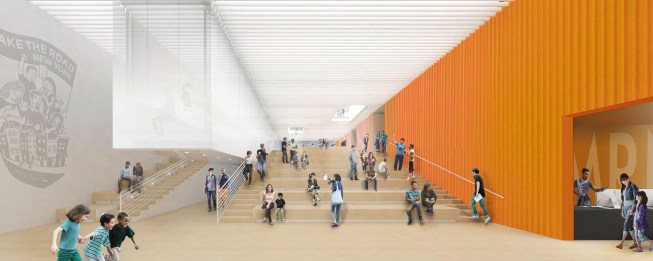
Courtesy Make the Road NY; TEN Arquitectos
Cutouts filter light into the interior of MRNY's new home
According to MRNY’s development director, Julie Miles, there’s been an increased focus on security staff training since Trump took office. The situation in the new building, she argues, “will not be very different from our current situation—storefront buildings with lots of glass—so we have protocols in place.” Valdés assured me that, whether the façade is opaque or transparent, ICE can’t enter the premises without a warrant: “What we wanted to do is make sure people feel welcome when they come in, and power in masses is very important in our community—that you’re not alone.” He went on to quote something that Enrique Norten said to him: “ ‘At the moment that Trump is trying to build up walls, we’re trying to break down walls and invite people in.’ ”
Steele echoed that sentiment: “The last thing— it goes without saying—the last thing we want to do is build a wall.”
